AUDI TT COUPE 2017 Owners Manual
Manufacturer: AUDI, Model Year: 2017, Model line: TT COUPE, Model: AUDI TT COUPE 2017Pages: 322, PDF Size: 79.73 MB
Page 261 of 322
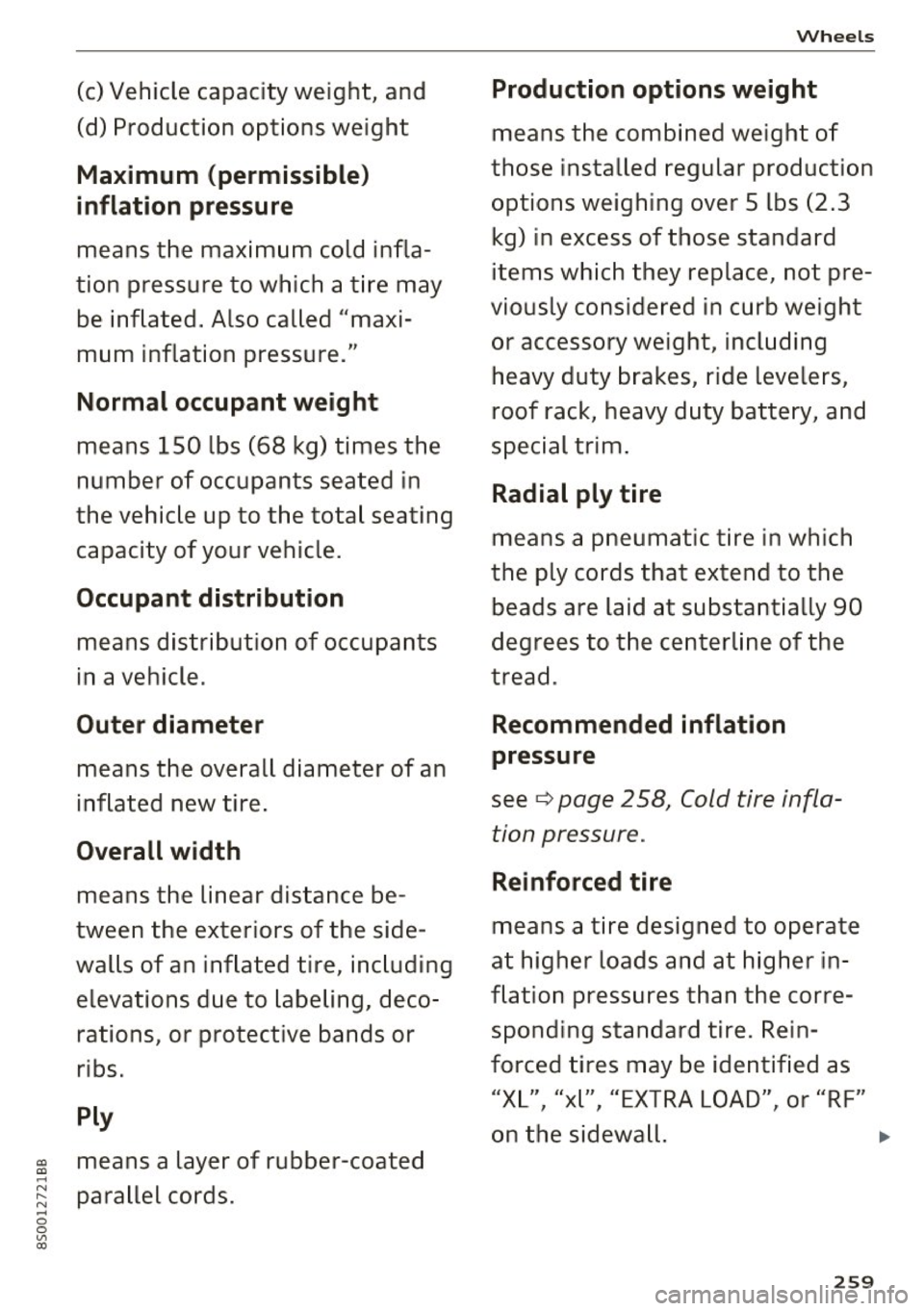
(c) Vehicle capacity weight, and
(d) Production options weight
Maximum (permissible)
inflation pressure
means the maximum cold infla
tion pressure to which a t ire may
be inflated. Also called "maxi
mum inflation pressure."
Normal occupant weight
means 150 lbs (68 kg) times the
number of occupants seated in
the vehicle up to the tota l seating
capacity of your vehicle.
Occupant distribution
means distribution of occupants
in a vehicle.
Outer diameter
means the overall diameter of an
inflated new tire .
Overall width
means the linear dis tance be
tween the exteriors of the side
walls of an inflated tire, including
elevations due to labeling, deco
rations, or protective bands or
ribs.
Ply
~ means a layer of rubber-coated ...
~ parallel cords . ... 0
0
V'> a:,
Wheels
Production options weight
means the combined weight of
those installed regular production
options weighing over 5 lbs (2.3 kg) in excess of those standard
items wh ich they replace, not pre
viously considered in curb weight
or accessory weight, including
heavy duty brakes, ride levelers,
roof rack , heavy d uty ba tte ry , and
special trim .
Radial ply tire
means a pneumatic tire in which
the ply cords that extend to the
beads ar e laid at substantia lly
90
degrees to the centerline of the
tread.
Recommended inflation
pressure
see c:::> page 258, Cold tire infla
tion pressure .
Reinforced tire
means a tire designed to operate
at higher loads and at higher in
fl at ion pressures than the corre
sponding standard tire. Rein
forced tires may be iden tified as
"X L" "x l" "EXTRA L OA D" or "RF" I 1 I
on the sidewall. ..,
259
Page 262 of 322
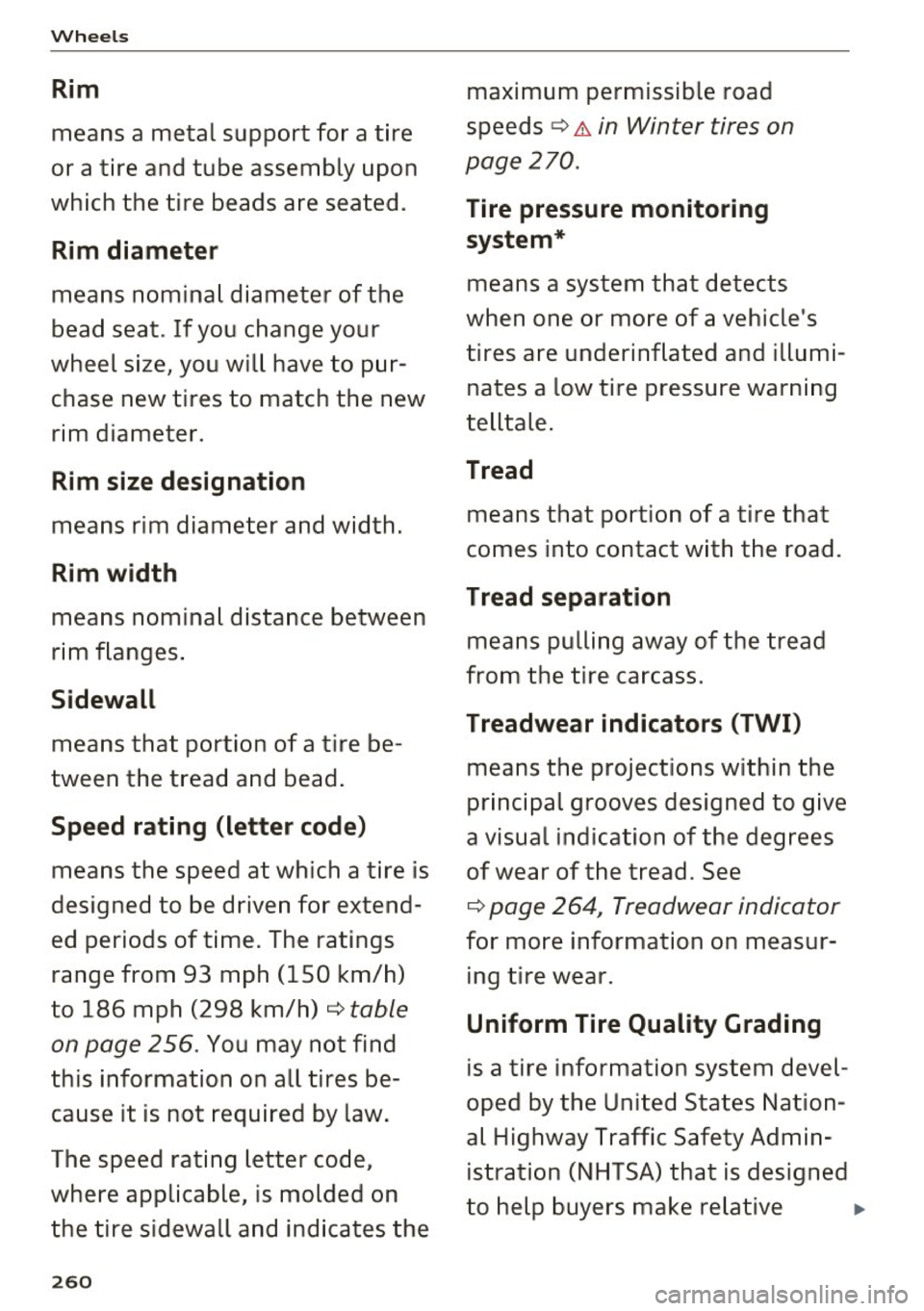
Wheels
Rim
means a metal support for a tire
or a tire and tube assembly upon
which the t ire beads are seated .
Rim diameter
means nominal diameter of the
bead seat . If you change your
wh eel size, you will have to p ur
chase new tires to match the new
rim d iameter .
Rim size designation
means rim diameter and w idth.
Rim width
means nomina l distance between
r im flanges .
Sidewall
means that portion of a t ire be
twee n the tread and bead .
Speed rating (letter code)
means the speed at which a t ire is
designed to be driven for extend
ed periods of ti me. The ratings
range from 93 mph (150 km/h)
to 186 mph (298 km/h)
¢ table
on page 256 .
You may not find
this information on all tires be
cause it is not required by law.
The speed rating letter code,
wh ere applicable, is molded on
the tire sidewall and ind icates the
260
maximum permissible road
speeds
¢ A in Winter tires on
page 270 .
Tire pressure monitoring
system *
means a system that detects
when one or mo re of a vehicle's
tires a re underinflated and illumi
nates a low tire pressure war ning
telltale .
Tread
means that portion of a tire that
comes into contact wi th the road.
Tread separation
means pulling away of the tread
from the tire carcass .
Treadwear indicators (TWI)
means the project ions wi thin the
pr inc ipal grooves designed to g ive
a visua l indication of the degrees
of wear of the tread . See
¢ page 264, Treadwear indicator
for mo re information on meas ur
ing tire wear.
Uniform Tire Quality Grading
i s a tire informa tion system devel
oped by the Unite d States Nation
a l Highway Traffic Safety Admin
istration (NHTSA) that is designed
to help buyers make re lative
..
Page 263 of 322
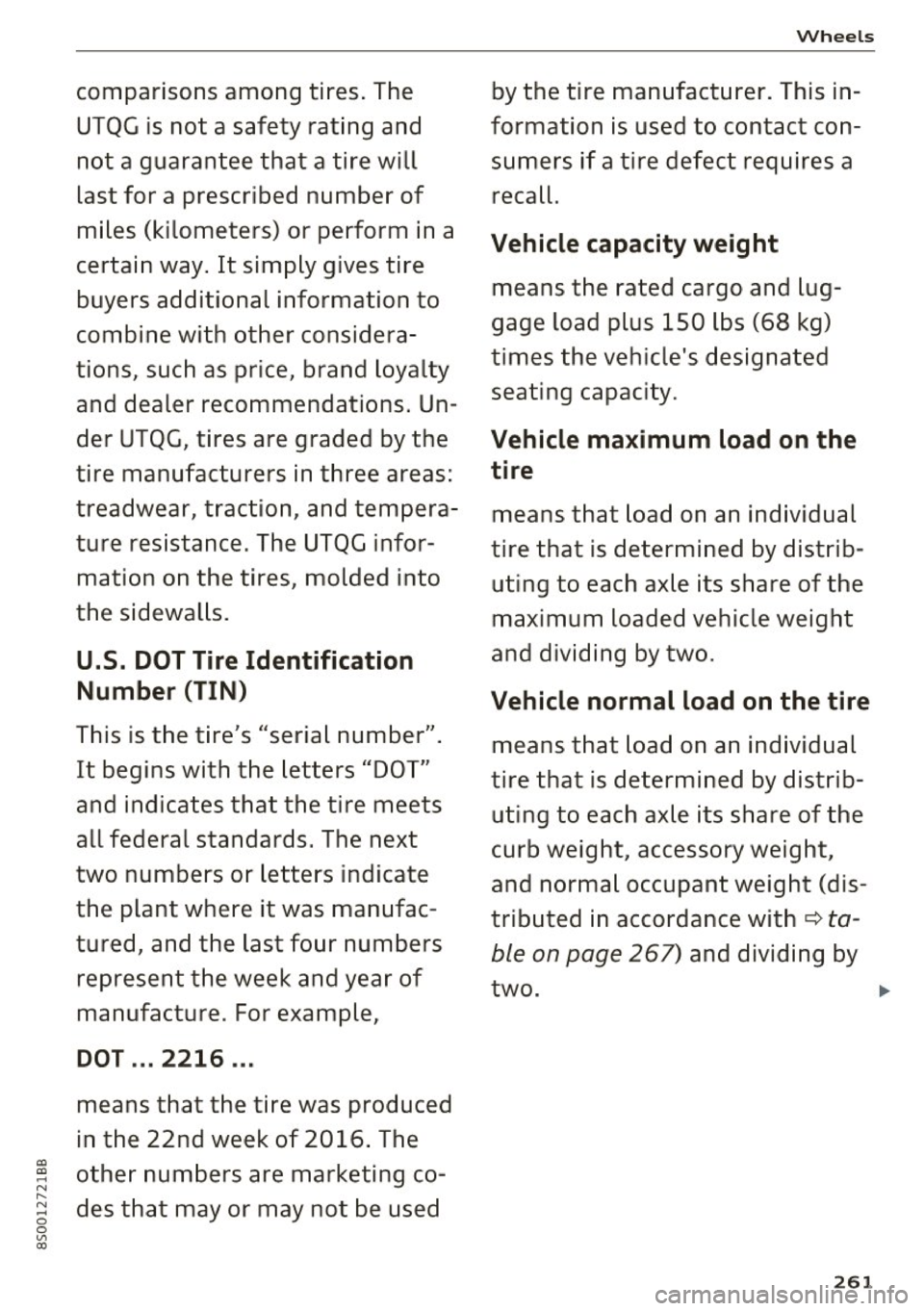
a, a, .... N
" N .... 0
0
V'> a:,
comparisons among tires. The
UTQG is not a safety rating and
not a guarantee that a tire will
last for a prescr ibed number of
miles (kilometers) or perform in a
certain way . It simply gives tire
buyers additional information to
combine with other considera
tions, such as price, brand loyalty and dealer recommendations. Un
der UTQG, tires are graded by the
tire manu facturers in three areas:
treadwear, traction, and tempera
ture res istance. The UTQG infor
mation on the tires, molded into
the sidewalls.
U.S. DOT Tire Identification
Number (TIN)
T his is the tire's "seria l number" .
It beg ins with the letters "DO T"
and indicates that the tire meets
all federal s tandards. The next
two numbers o r letters indicate
the plant where it was manufac
tured , and the last four numbers
represent the week and year of
manufactu re . For example,
DOT ... 2216 ...
means that the tire was produced
in the 22nd week of 2016 . The
other numbers are marketing co des that may or may not be used
Wheels
by the tire man ufact urer. This in
formation is used to contact con
sumers if a tire defect requires a
recall.
Vehicle capacity weight
means the rated cargo and lug
gage load plus 150 lbs (68 kg)
times the vehic le's designated
seating capacity.
Vehicle maximum load on the
tire
means that load on an individual
tire that is deter mined by dist rib
uting to each ax le its share of the
maximum loaded vehicle weight
an d div id ing
by two.
Vehicle normal load on the tire
means that load on an individual
tire that is determined by distrib uting to each ax le its share of the
curb weight, accessory weight,
and normal occupant weight (dis
trib uted in acco rdance with
q ta
ble on page 26 7) and divid ing by
two. .,.
261
Page 264 of 322
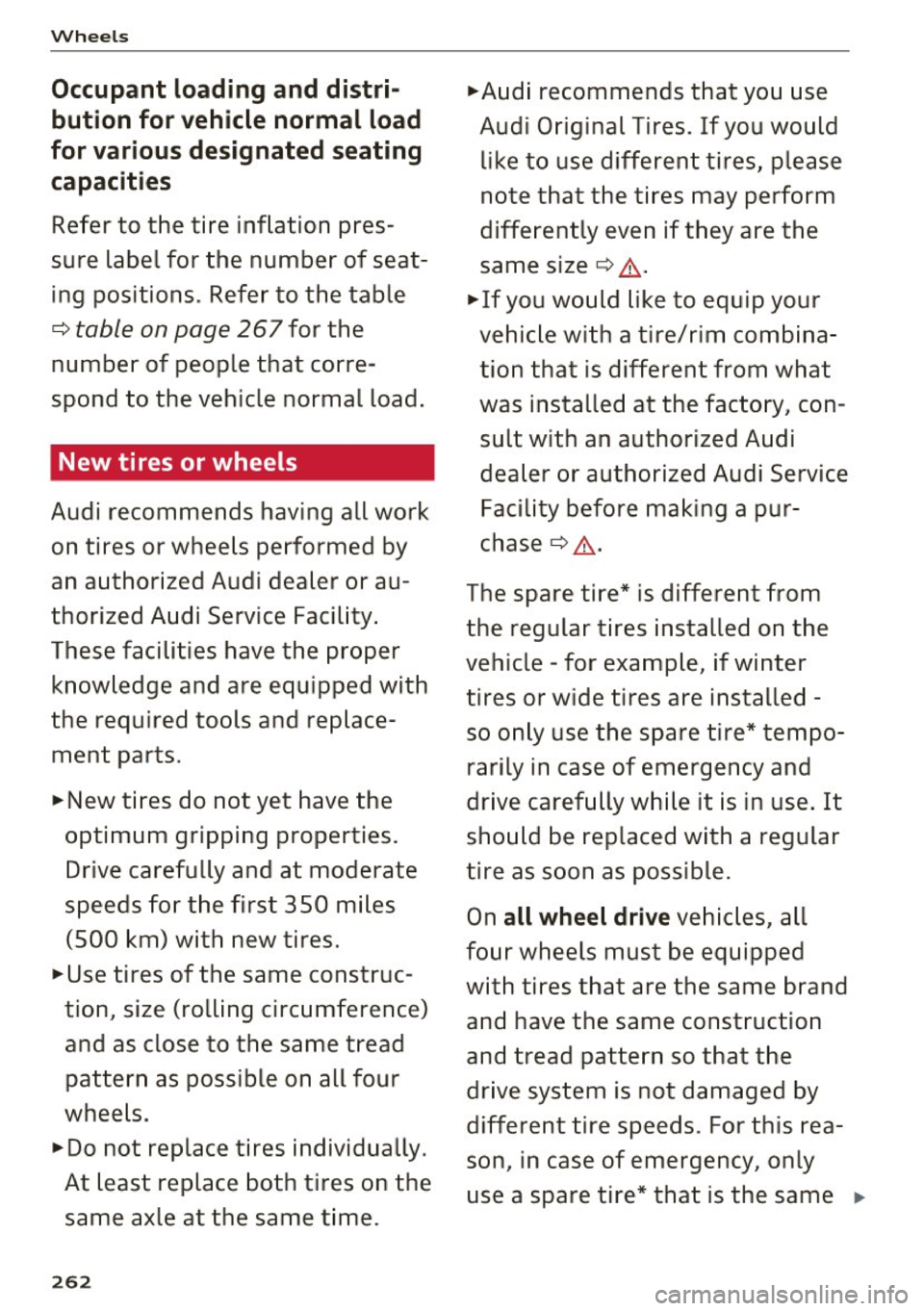
Wheel s
Occupant loading and distri
bution for vehicle normal load
for various designated seat ing
capacit ies
Refer to the tire inflation pres
sure label for the number of seat ing positions . Refer to the table
c:::> table on page 267 for the
number of people that corre
spond to the vehicle normal load .
New tires or wheels
Audi recommends having all work
on tires or wheels performed by
an authorized Audi dealer or au
thorized Audi Service Facility.
These facilities have the proper knowledge and are equipped with
the required tools and replace ment parts .
.,.. New tires do not yet have the
optimum gripping properties.
Dr ive carefully and at moderate
speeds for the first 350 miles (500 km) with new tires.
.,.. Use tires of the same construc
tion, size (rolling circumference)
and as close to the same tread
pattern as possible on all four
wheels .
.,.. Do not replace tires individually.
At least replace both tires on the same axle at the same time.
262
.,.. Audi recommends that you use
Aud i Orig inal Tires. If you would
like to use different tires, please
note that the tires may perform
diffe rently even if they are the
same size
c:::> &. -
.,.. If you would like to equip your
vehicle with a tire/rim combina
tion that is different from what
was installed at the facto ry, con
sult with an authorized Audi
dealer or authorized Audi Service
Facility before making a pur
chase
c:::> & -
The spare tire* is different from the regular tires installed on the
vehicle -for example, if winter
tires or wide t ires are installed -
so only use the spare tire* tempo
rarily in case of emergency and
drive carefully while it is in use . It
should be replaced with a regular
tire as soon as possible.
On
all wheel drive vehicles, all
four wheels must be equipped
with tires that are the same brand and have the same construction
and tread pattern so that the
drive system is not damaged by
different tire speeds . For this rea
son, in case of emergency, only
use a spare tire* that is the same .,..
Page 265 of 322
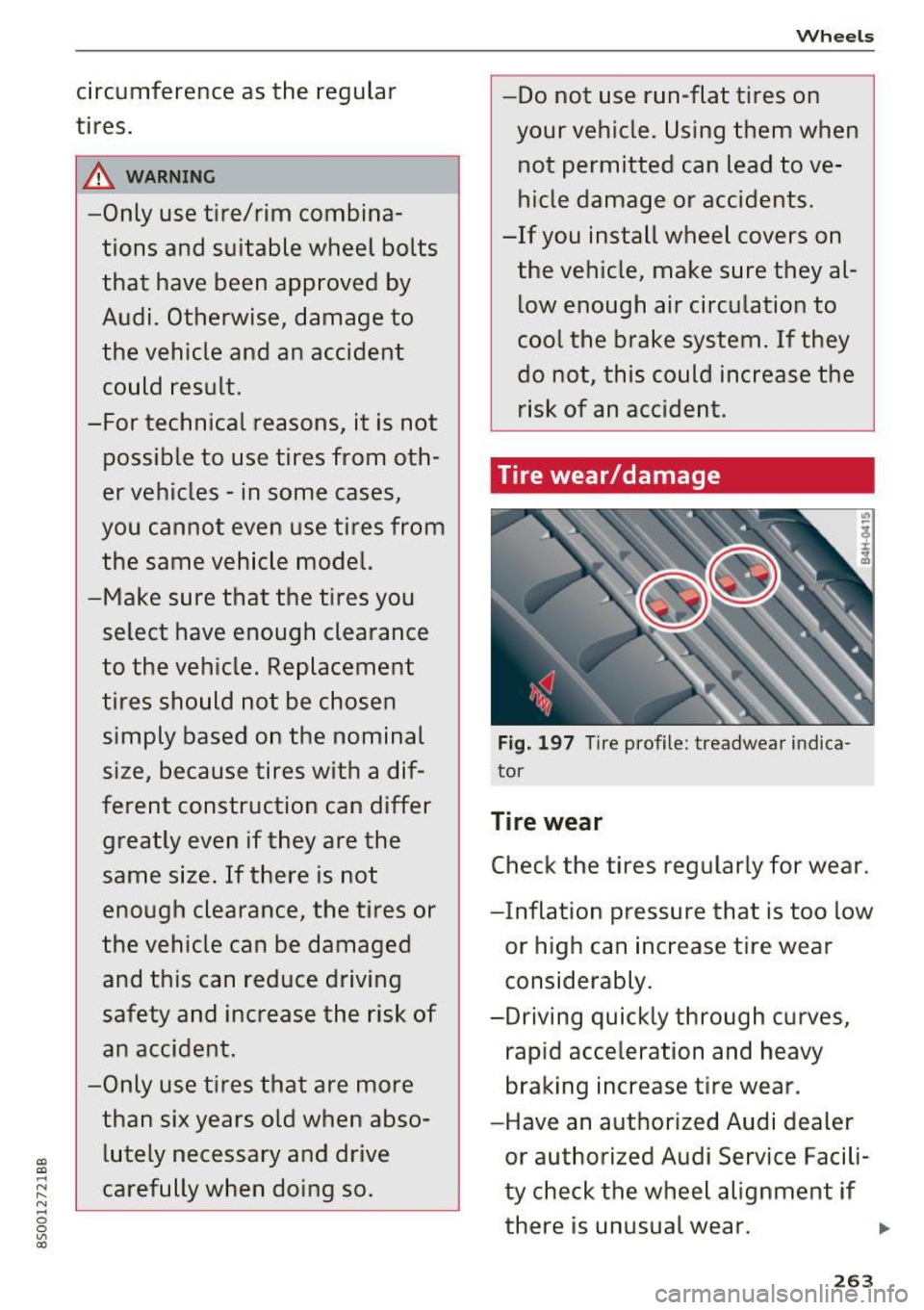
"'
"' ....
N
" N .... 0 0
"' CX)
circumference as the regular
tires .
8,_ WARNING , -
-Only use tire/rim combina-
tions and suitable wheel bolts
that have been approved by
Audi. Otherwise, damage to
the vehicle and an accident
could result.
-For technical reasons, it is not possible to use tires from oth
er vehicles -in some cases,
you cannot even use tires from
the same vehicle model.
-Make sure that the tires you select have enough clearance
to the vehicle. Replacement
tires should not be chosen simply based on the nominal
size, because tires with a dif
ferent construction can differ greatly even if they are the
same size. If there is not
enough clearance, the tires or
the vehicle can be damaged
and this can reduce driving
safety and increase the risk of
an accident.
-Only use tires that are more
than six years old when abso
lutely necessary and drive
carefully when doing so.
Wheels
-Do not use run-flat tires on
your vehicle. Using them when
not permitted can lead to ve hicle damage or accidents.
-If you install wheel covers on
the vehicle, make sure they al
low enough air circulation to
cool the brake system. If they
do not, this could increase the
risk of an accident.
Tire wear/damage
Fig. 197 Tire profile : treadwear indica
tor
Tire wear
Check the tires regularly for wear .
-Inflation pressure that is too low
or high can increase tire wear
considerably.
-Driving quickly through curves, rapid acceleration and heavy
braking increase tire wear .
-Have an authorized Audi dealer
or authorized Audi Service Facili
ty check the wheel alignment if
there is unusual wear.
263
..
Page 266 of 322
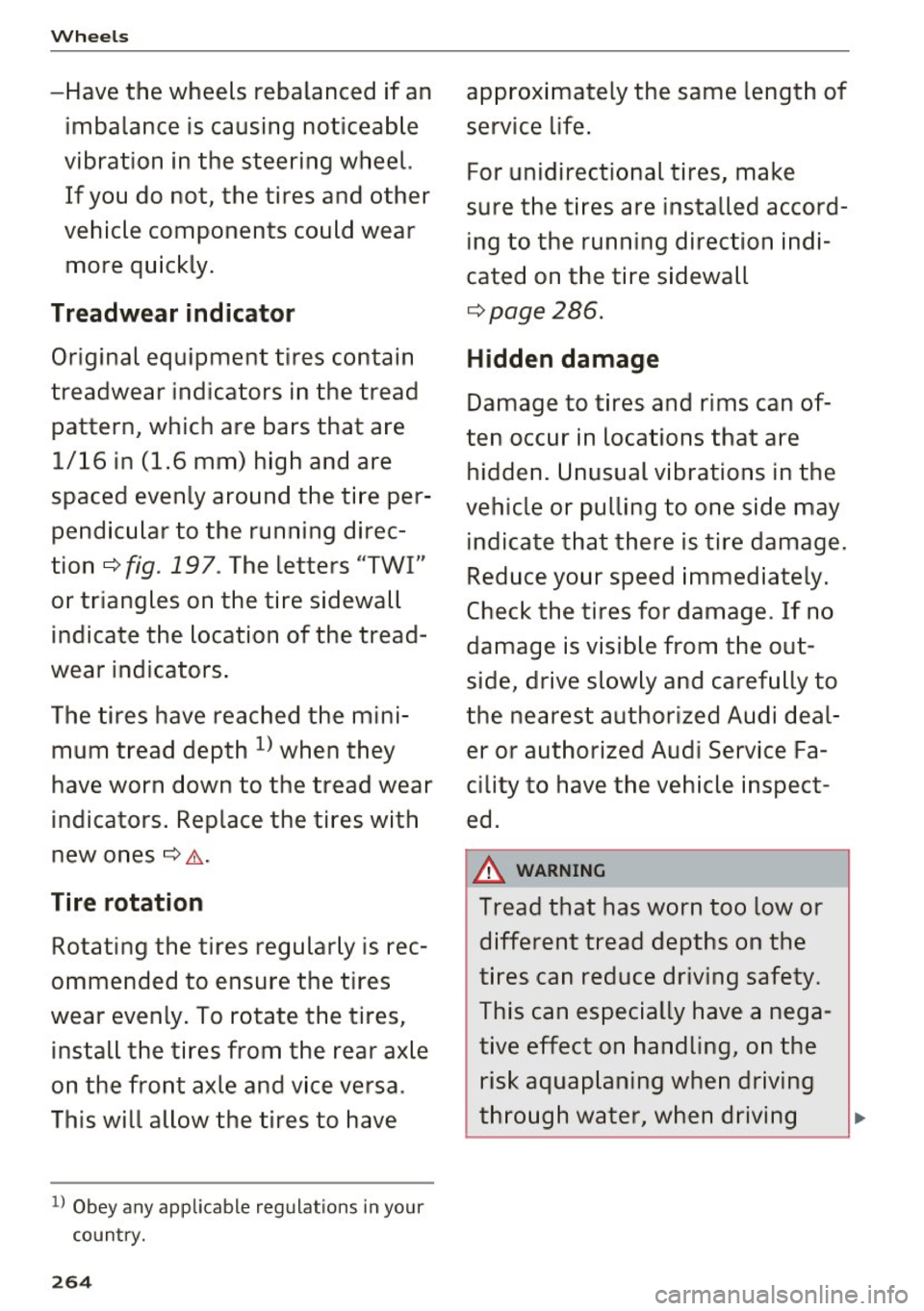
Wheels
-Have the wheels rebalanced if an imbalance is causing noticeable
vibration in the steering wheel.
If you do not, the tires and other
vehicle components could wear
more quickly.
Treadwear indicator
Original equipment tires contain
treadwear indicators in the tread
pattern, which are bars that are
1/16 in (1.6 mm) high and are
spaced evenly around the tire per pendicular to the running direc
tion¢
fig . 197 . The letters "TWI"
or triangles on the tire sidewall indicate the location of the tread
wear indicators.
The tires have reached the mini mum tread depth
l) when they
have worn down to the tread wear
indicators . Replace the tires with
new ones ¢A.
Tire rotation
Rotating the tires regularly is rec
ommended to ensure the tires
wear evenly. To rotate the tires,
install the t ires from the rear axle
on the front axle and vice versa .
This will allow the tires to have
1> Obey any applicable regulations in your
country.
264
approximately the same length of
service life.
For unidirectional tires, make
sure the tires are installed accord
ing to the running direction indi
cated on the tire sidewall
¢page 286.
Hidden damage
Damage to tires and rims can of
ten occur in locations that are hidden. Unusual vibrations in the
vehicle or pulling to one side may indicate that there is tire damage.
Reduce your speed immediately.
Check the tires for damage . If no
damage is visible from the out
side, drive slowly and carefully to
the nearest authorized Audi deal er or authorized Audi Service Fa
cility to have the vehicle inspect
ed.
8_ WARNING
Tread that has worn too low or different tread depths on the
tires can reduce driving safety.
This can especially have a nega
tive effect on handling, on the risk aquaplaning when driving
through water, when driving ,..
Page 267 of 322
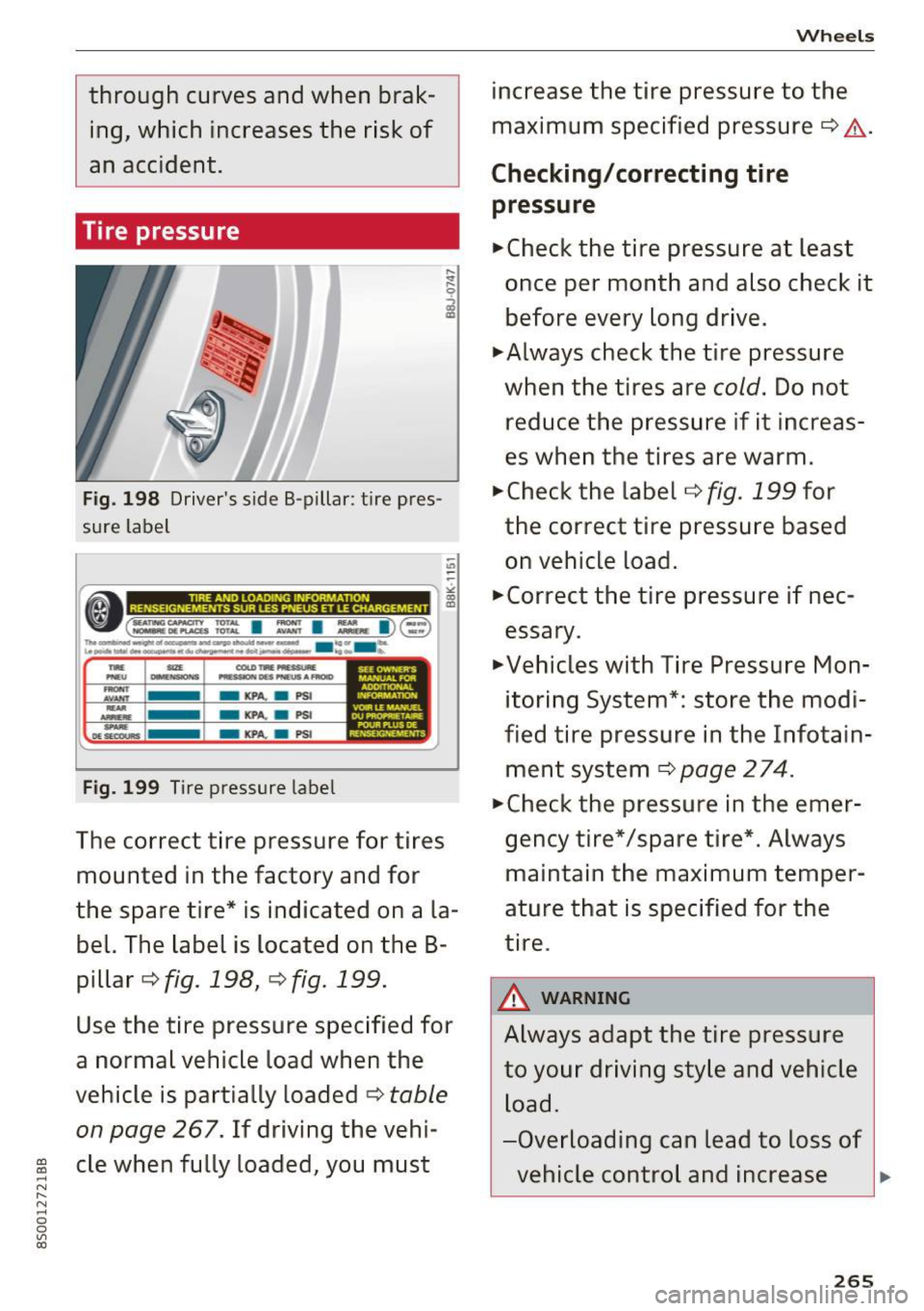
al
al
.... N
" N .... 0
0
V'l al
through curves and when braking, which increases the risk of
an accident.
Tire pressure
Fig. 198 Driver's sid e B-pillar : tir e pres
sure label
"' -
-~-------------------,£
tM£. IIZl COLO tlllf fllllESSt.lW. PNfU Nl:4fN$IOM$ "IIISaoN OE$ PMEU$ A FROID
-AYIJff -KPA, a PSI
Fig. 199 Tire pressure label
The correct tire pressure for tires
mounted in the factory and for
the spare t ire* is indicated on a la
bel. The label is located on the B
pillar ¢
fig. 198, ¢ fig. 199.
Use the tire pressure specified for
a normal vehicle load when the
vehicle is partially loaded¢
table
on page
267. If driving the vehi
cle when ful ly loaded, you must
Wheels
increase the tire pressure to the
maximum specified pressure¢&.-
Checking/correcting tire
pressure
.,,.Check the tire pressure at least
once per month and also check it before every long drive .
.,,.Always check the tire pressure
when the tires are
cold. Do not
reduce the pressure if it increas
es when the tires are warm .
... check the label ¢
fig. 199 for
the correct tire pressure based on vehicle load.
.,,.Correct the tire pressure if nec
essary.
... vehicles with Tire Pressure Mon
itoring System*: store the modi
fied tire pressure in the Infotain
ment system
¢page 274.
.,,.Check the pressure in the emer
gency tire*/spare t ire*. Always
maintain the maximum temper
ature that is specified for the
tire .
_& WARNING
Always adapt the tire pressure
to your driving style and vehicle
load.
-Overloading can lead to loss of vehicle control and increase ...
265
Page 268 of 322
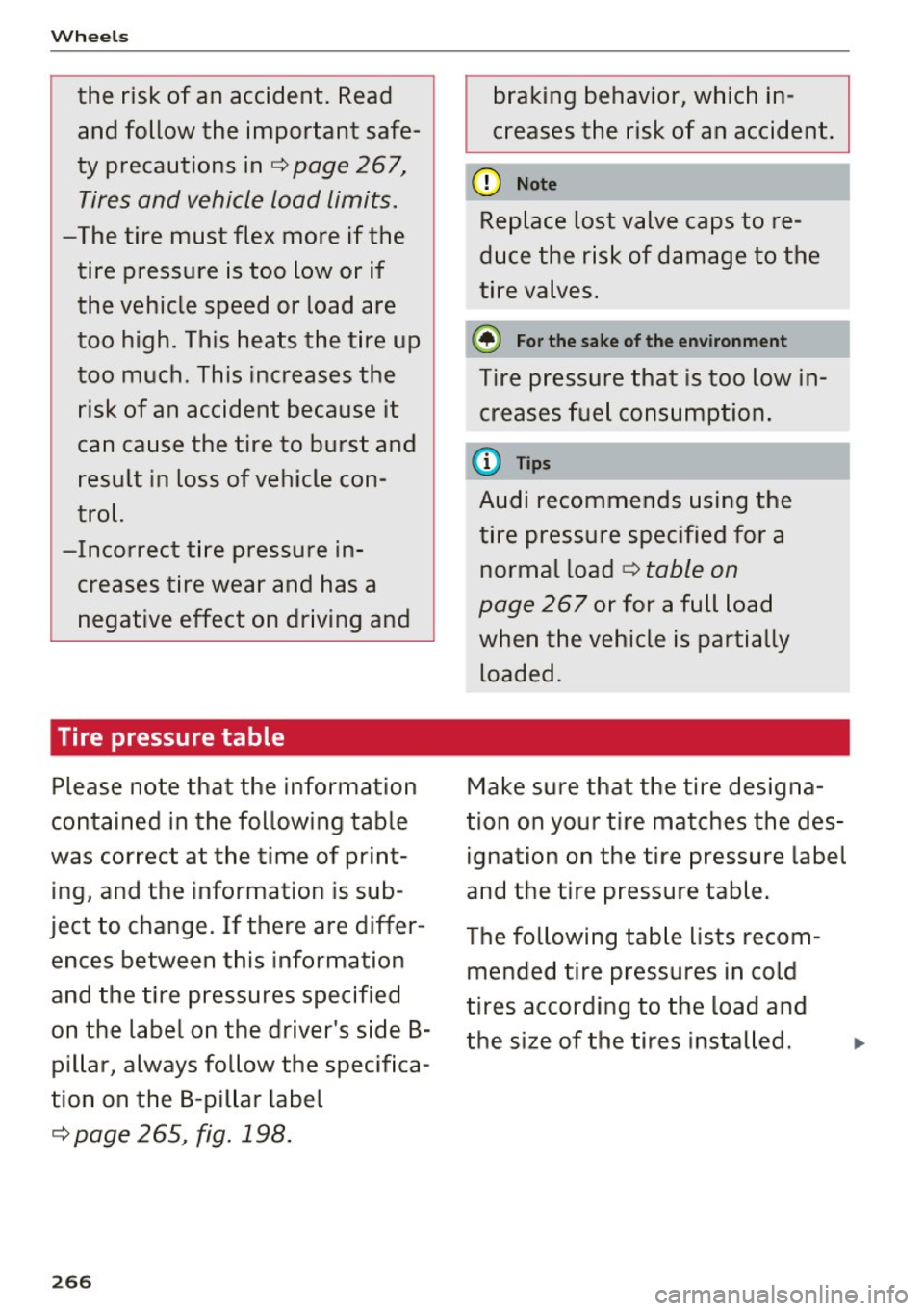
Wheels
the risk of an accident. Read and follow the important safe
ty precautions in ¢ page 267,
Tires and vehicle load limits.
-The tire must flex more if the tire pressure is too low or if
the vehicle speed or load are
too high. This heats the tire up
too much. This increases the risk of an accident because it
can cause the tire to burst and
result in loss of vehicle con
trol.
- Incorrect tire pressure in
creases tire wear and has a
negative effect on driving and
Tire pressure table
Please note that the information
contained in the following table
was correct at the time of print ing, and the information is sub
ject to change. If there are differ
ences between this information
and the tire pressures specified
on the label on the driver's side B
p illar, always follow the spec ifica
tion on the B-pillar label
¢ page 265, fig. 198.
266
braking behavior, which in
creases the risk of an accident.
(D Note
Replace lost valve caps to re
duce the risk of damage to the
tire valves.
@ For the sake of the environment
Tire pressure that is too low in
creases fuel consumption.
(D Tips
Audi recommends using the
tire pressure specified for a normal load
¢ table on
page 267
or for a full load
when the vehicle is partially
loaded.
Make sure that the tire designa
tion on your tire matches the des
ignation on the tire pressure label
and the tire pressure table.
The following table lists recom
mended tire pressures in cold
tires according to the load and
the size of the tires installed.
Page 269 of 322
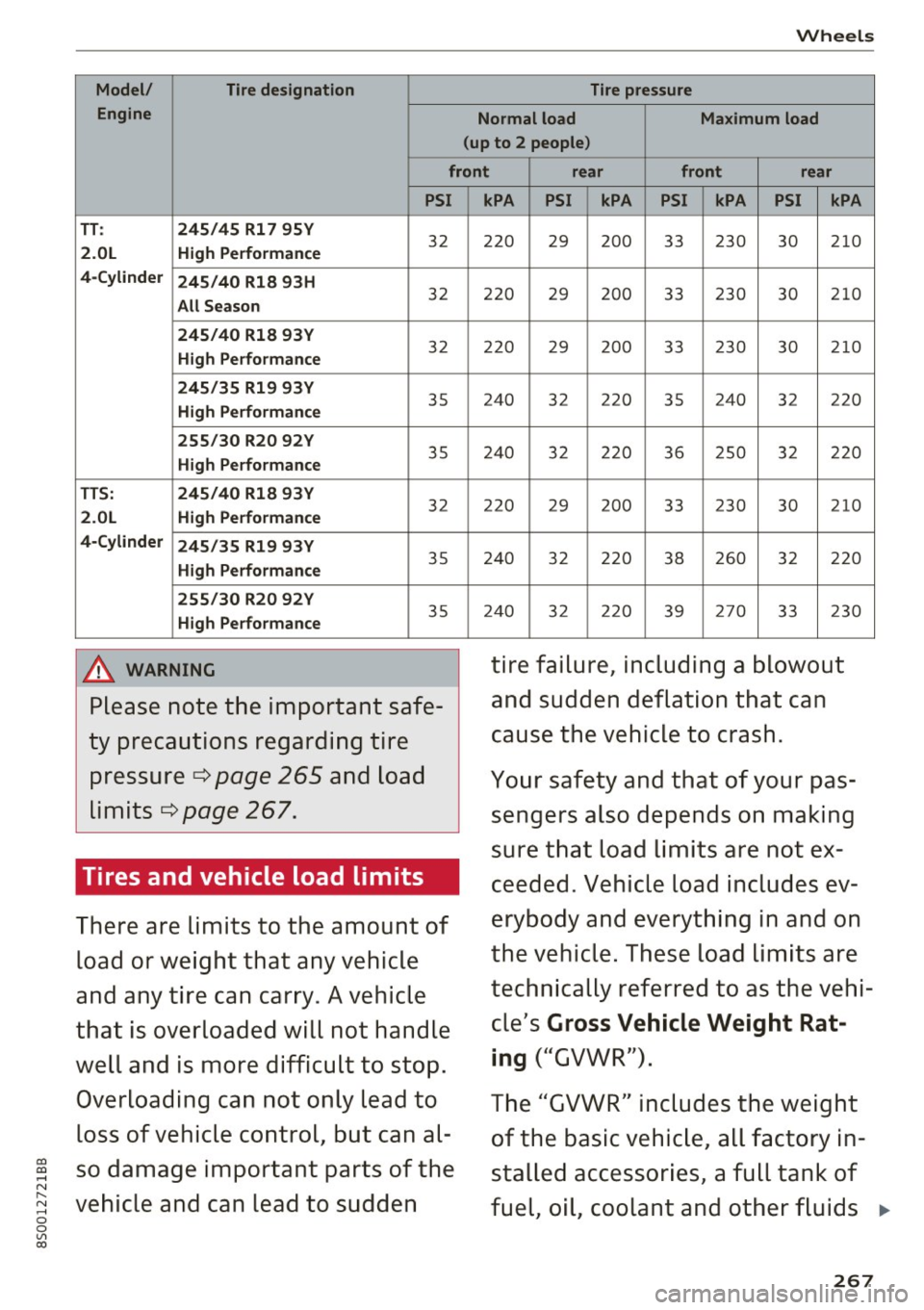
co
co
.... N
" N .... 0
0
Vl c:o
Wheels
Model/ Tire designation Tire pressure
Engine Normal load Maximum load
(up to 2 people)
front rear front rear
PSI
TT: 245/45 R17 95V
32 2.0L High Performance
4-Cylinder 245/40 R18 93H
All Season
32
245/40 R18 93V 32 High Performance
245/35 R19 93V
35 High Performance
255/30 R20 92V
35 High Performance
TTS: 245/40 R18 93V
32
2.0L High Performance
4-Cylinder 245/35 R19 93V
High Performance
35
255/30 R20 92V
35 High Performance
A WARNING
Please note the important safe
ty precautions regarding tire pressure
¢ page 265 and load
limits
¢ page 267.
Tires and vehicle load limits
There are limits to the amount of
load or weight that any vehicle
and any tire can carry. A vehicle
that is overloaded will not handle
well and is more difficult to stop. Overloading can not only lead to
loss of vehicle control, but can al
so damage important parts of the
vehicle and can lead to sudden
kPA PSI kPA PSI kPA PSI kPA
220 29 200 33 230 30 210
220 29 200 33 230 30 210
220 29 200 33 230 30 210
240
32 220 35 240
32 220
240 32 220 36 250 32 220
220 29 200 33 230
30 210
240 32 220 38 260 32 220
240 32 220 39 270 33 230
tire failure, including a blowout
and sudden deflation that can
cause the vehicle to crash.
Your safety and that of your pas
sengers also depends on making
sure that load limits are not ex
ceeded. Vehicle load includes ev
erybody and everything in and on
the vehicle. These load limits are
technically referred to as the vehi cle 's
Gross Vehicle Weight Rat
ing
("GVWR").
The "GVWR" includes the weight of the basic vehicle, all factory in
stalled accessories, a full tank of
fuel, oil, coolant and other fluids ..
267
Page 270 of 322
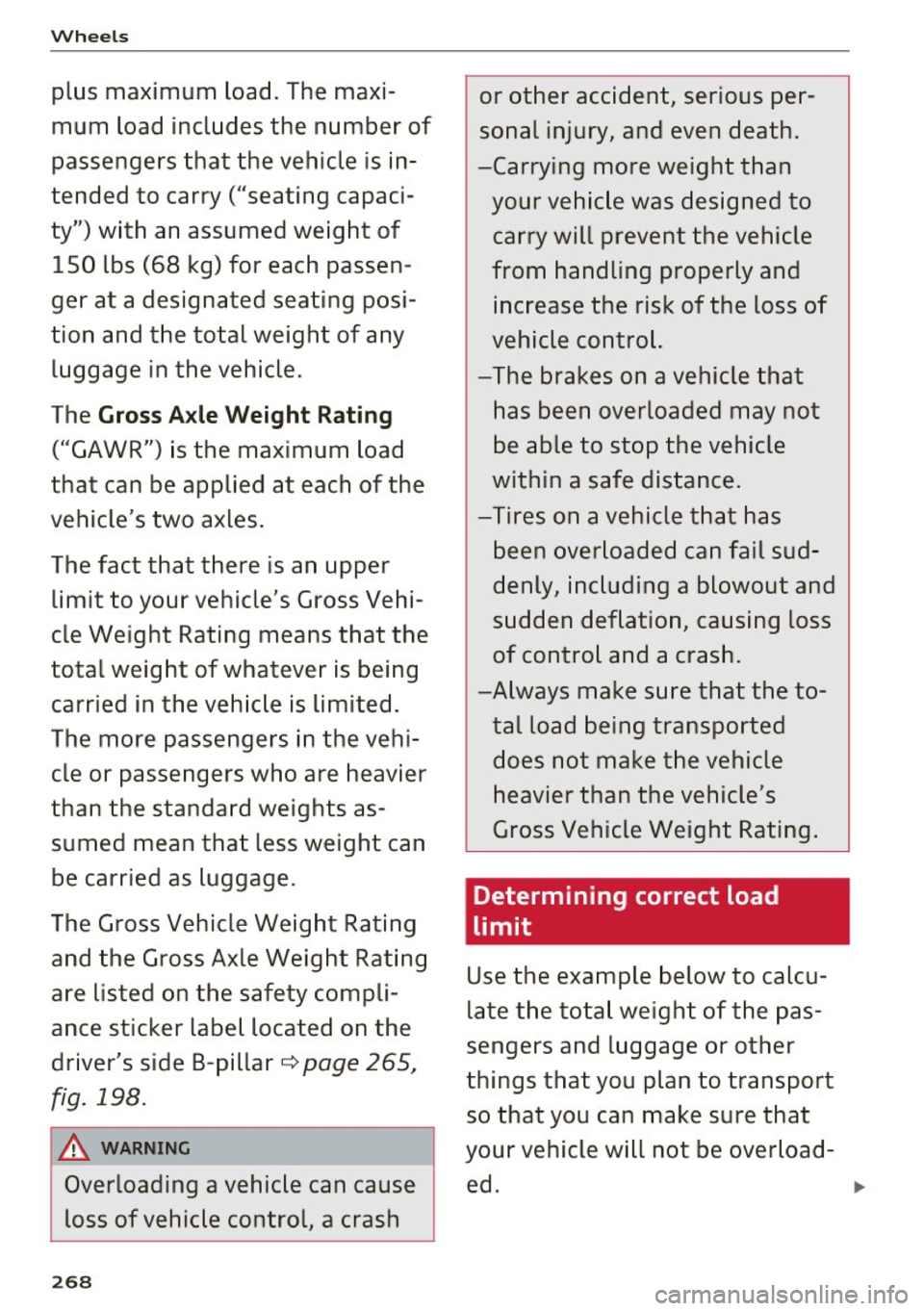
Wheels
plus maximum load. The maxi
mum load includes the number of
passengers that the vehicle is in
tended to carry ("seating capaci
ty") with an assumed weight of 150 lbs (68 kg) for each passen
ger at a designated seating posi
tion and the total weight of any luggage in the vehicle.
The
Gross Axle Weight Rating
("GAWR") is the maximum load
that can be applied at each of the
vehicle's two axles.
The fact that there is an upper limit to your vehicle's Gross Vehi
cle Weight Rating means that the
total weight of whatever is being
carried in the vehicle is limited.
The more passengers in the vehi cle or passengers who are heavier
than the standard weights as
sumed mean that less weight can
be carried as luggage.
The Gross Vehicle Weight Rating and the Gross Axle Weight Rating
are listed on the safety compli
ance sticker label located on the
driver's side B-pillar
c::> page 265,
fig. 198.
A WARNING
Overloading a vehicle can cause
loss of vehicle control, a crash
268
or other accident, serious per
sonal injury, and even death.
-Carrying more weight than your vehicle was designed to carry will prevent the vehicle
from handling properly and
increase the risk of the loss of
vehicle control.
-The brakes on a vehicle that has been overloaded may not
be able to stop the vehicle
within a safe distance.
-Tires on a vehicle that has been overloaded can fail sud
denly, including a blowout and
sudden deflation, causing loss
of control and a crash.
-Always make sure that the to
tal load being transported does not make the vehicle
heavier than the vehicle's
Gross Vehicle Weight Rating.
Determining correct load
limit
Use the example below to calcu
late the total weight of the pas
sengers and luggage or other
things that you plan to transport
so that you can make sure that
your vehicle will not be overload- ed . ..